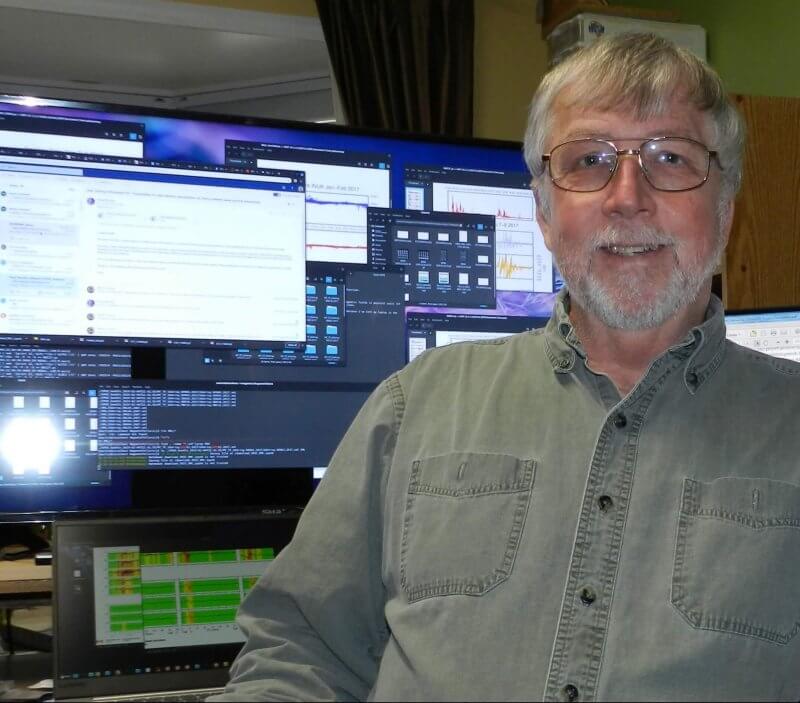Athabasca University physicist’s discovery published in Nature Communications
An Athabasca University physics professor’s collaboration with researchers from across the ocean has led to a greater understanding of the radiation affecting – and potentially damaging – satellites in Earth’s orbit.
Dr. Martin Connors is part of a team that includes lead researcher Dr. Mitsunori Ozaki and colleagues from Kanazawa University, Nagoya University, and several others in Japan. Their groundbreaking research on rapidly varying auroras has just been published in Nature Communications.
The team determined that a type of certain types of aurora – also known as northern lights – actually “flash” rapidly. This is no small feat, considering that the flashes last less than a second. Special intensified equipment, also used to study other faint auroras, led to the discovery.
“This measurement is very difficult,” Connors said. “The light is very faint, and this is a measurement of that light flickering fast, so you don’t have that much light to work with.”
The research paper, entitled Visualization of rapid electron precipitation via chorus element wave-particle interactions, was published Jan. 16, 2019.
Satellite data

Thanks to data collected from the Japanese Arase satellite in orbit and from the state-of-the-art instrumentation on the ground (in this study, in Alaska) a link can be made between what is sending electrons in bursts to Earth, and the flashing auroras near the ground. Athabasca University Geophysical Observatory II (AUGO II) in Athabasca County has participated in similar studies, including some involving another type of faint aurora caused by protons being sent Earthward.
In this case, the particles are electrons, and they are shot towards Earth by waves known as chorus waves, which once detected, make music or bird-like sounds. You can hear these sounds by visiting the ERG Science Center website, and clicking the play button next to the images.
“By putting the two measurements together, you can figure out what’s going on in space that makes these particles come down,” Connors said.
Auroras are caused by the solar wind interacting with the region near Earth in space. Most auroras visible in northern Alberta are caused by electrons hitting gas in the atmosphere, similar to how fluorescent lights work. Fluorescent lights in our homes flicker with the 60 cycle per second pulse of our electricity, much like how auroras are caused by chorus waves flickering too fast to be picked up by the eye. In addition, the innocent-sounding chorus waves can cause electrons to gain so much energy that they pose a danger to objects in space. We are thankfully protected by Earth’s atmosphere here on the the ground.
“The stuff up there can and does do damage. Satellites have been lost, notably the one that I worked on 10 years go. It was a telecom satellite, and it just got blasted for no particular reason. It was just in the wrong place at the wrong time,” Connors said. “The connection to what we’re measuring is that we want to better understand the processes.”
Considering how crucial satellite-based telecommunications have become in modern society, like if you’re reading this on a cell phone that depends on these satellites – the importance of this type of work is evident.
Collaboration is key
Connors said having the ability to collaborate on this kind of work with other researchers from around the world is crucial, and he wouldn’t be able to do the work he does without it.
“I’m one faculty member working on this problem, whereas most bigger universities would have a group doing it,” he said. “So my collaborations with other groups are pretty important.”
The AUGO, which is at Athabasca University’s main campus in Athabasca, and AUGO II, which is 40 km away from the light pollution that comes in an urban environment, were both made possible with the support of the Canada Foundation for Innovation.
Connors added his work is also made possible by a lot of guest instrumentation from his colleagues in Japan, which is essentially state-of-the-art technology. And as technology improves, researchers will be able to further refine their results and their understanding of this phenomenon.
“There are developing theories around, and the more measurements you can make, the more you can verify those theories and know which one is correct,” he said.